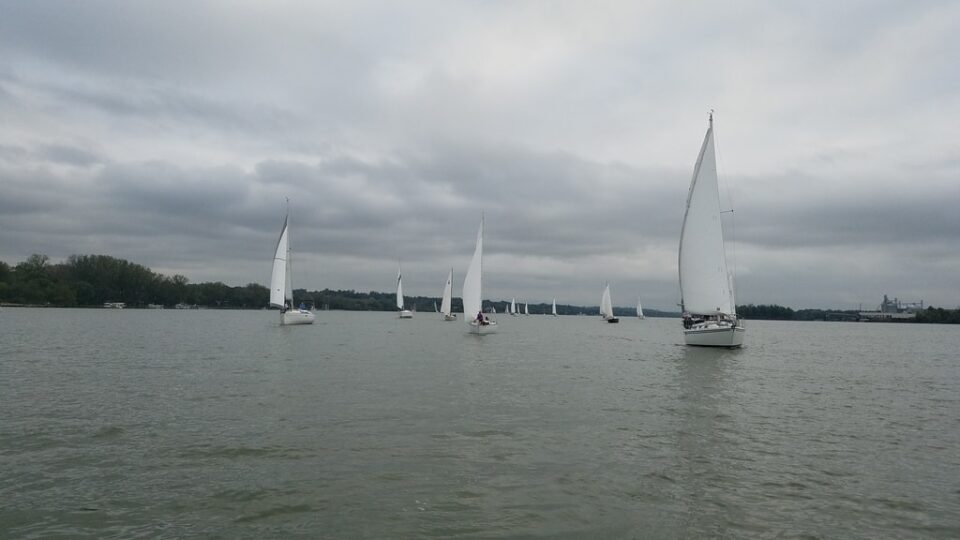What Makes a Good Blue Water Cruising Sailboat
Before we get started, to analyze the features that make a good sailboat, I’d like to have you all take a seat please— and stop sharpening those knives! That includes you, sir, with the calloused hands and wood shavings in your beard!
For some reason, boat talk can bring out the ogre in some people, which is too bad. One of the great things about sailing is the incredible diversity of sailboats to do it in: big sailboats, little sailboats, wide sailboats, skinny sailboats, monohulls, multihulls, wood sailboats, fiberglass sailboats, steel sailboats, aluminum sailboats—even sailboats made of cement! The number of sailboat types that continue to be built and sailed, even today, is truly incredible.
My own “breakthrough” in appreciating boat diversity came a few years ago on a bareboat charter cruise on Lake Erie with my wife. As I’ve intimated elsewhere, there was a time when I wanted nothing to do with any boat that wasn’t either a racer or an old classic with heartbreaking overhangs. Then along came this charter aboard a 34-footer of the type I had always dismissed as being the epitome of a soulless “plastic” cruiser.
In fact, I had barely set foot aboard that little trim vessel before I realized how wrong and even downright ignorant I’d been. The marina was as crowded as a shopping mall on the day after Thanksgiving, but we backed that handy little sloop out of her slip and turned toward the channel pretty as you please. A couple of hours later, a line of thunderheads rumbled in from the northwest, and we had to reef down for a bit of a squall, but again, there was no problem—despite some hail and about 35 knots of wind.
That night we relaxed in the comfortable cockpit, slowly working our way through a bottle of wine. Then we went below for a good night’s rest in the boat’s spacious aft stateroom. The next morning we awoke refreshed, had breakfast, and then headed back out onto the lake, ready and eager to do it all over again. In short, we had an absolutely fantastic time, and the boat performed splendidly in every way. It really was a revelation, both the quality of the boat and the realization of my own pig-headedness.
This is not to say that all boats are good for all purposes. Deepwater cruisers need to meet certain criteria that make them markedly different from top-flight racers. The same goes for daysailers and coastal cruisers. The point is, each design has to be judged on its merits and in the context of the boat’s intended purpose. Assuming the builder has successfully executed the design, whether or not the boat is a good one ultimately depends on the sailor.
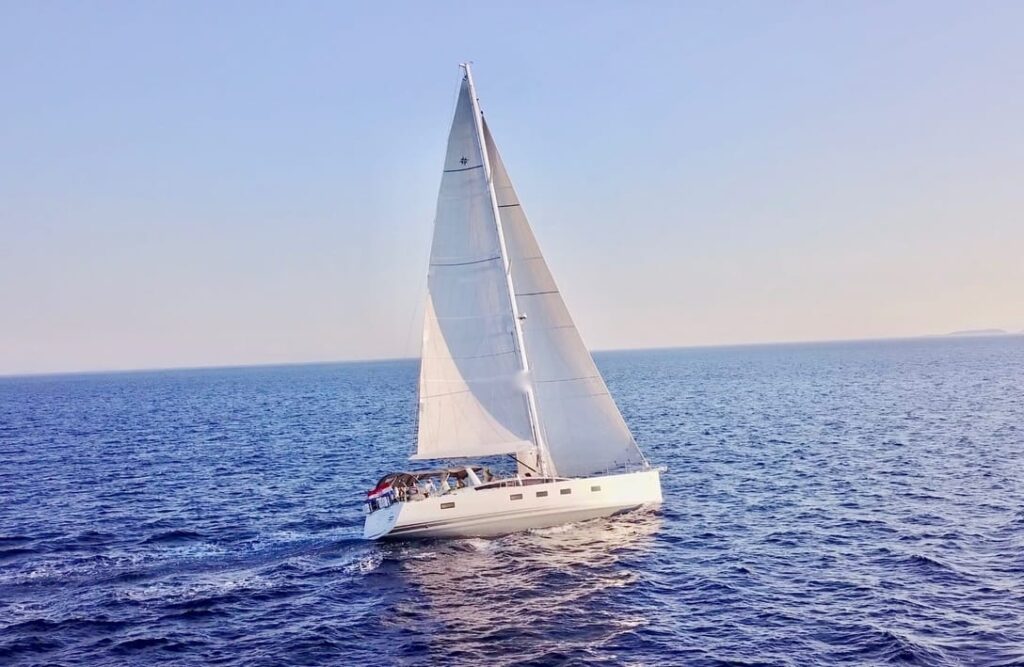
>>Also Read: Sailing Pre-Departure Checklist
What Makes a Good Blue Water Sailboat?
When it comes to crossing oceans with a sailboat, you obviously need a sturdy, reliable boat in the event you meet serious winds. The ideal bluewater cruiser, however, can’t be simply a waterborne tank—otherwise, it will take forever and a day to get anywhere, and you’ll be sitting duck for any storm heading your direction. In addition, the ideal cruising boat needs to take care of its crew on days when it isn’t blowing stink—days that far outnumber the stormy ones. It also needs to provide a comfortable place to rest and relax at the end of a day’s sail—not a trivial consideration, as even the most dedicated cruiser spends substantially more time at anchor or tied to the dock than out on the briny. Even an aggressive circumnavigation schedule will generally allow the crew two days in port for every day of sailing.
Finally, a bluewater cruiser needs to be both seaworthy and sea-kindly in its design and construction—that is, it must be able to both stand up to the rigors of heavy weather and spare the crew undue fatigue in the course of a typical passage. This is a boat that sails well but doesn’t require tremendous effort to keep it in trim. It’s a boat that tracks well—i.e., it’s steady on its helm—and has easy motion, so the crew doesn’t get banged up every time the weather starts kicking up some waves.
Here Is A Short List of Characteristics That Make a Good Offshore Sailboat
Structure and Equipment Installation
To be truly seaworthy, a boat must be structurally sound and its equipment correctly installed. The hull-to-deck joint must be well made, and all bulkheads and other interior structural elements should be securely bonded to the underside of the deck and inside of the hull. Equally important, items like hatches, rudder bearings, and steering gear need to be robustly constructed and robustly installed, so they can withstand the force of a crashing sea.
On deck, a deepwater cruiser should have tall stanchions set in sturdy bases. It will often have bulwarks—or at the very least, toerails—to brace your feet against if you ever find yourself sliding down the deck when the boat is on its ear. There should be plenty of sturdy handrails along the cabintop so that you never have to make any kind of “leap of faith,” lunging from one handhold to the next when moving forward to the mast or foredeck. There should also be adequate side deck space between the cabin trunk and the bulwarks or toerail so that going forward isn’t a struggle. And, of course, the side decks and foredeck should be surfaced with aggressive nonskid. Beware of stylishly molded cabin trunks—their gracefully curved surfaces can be treacherous in rough weather.
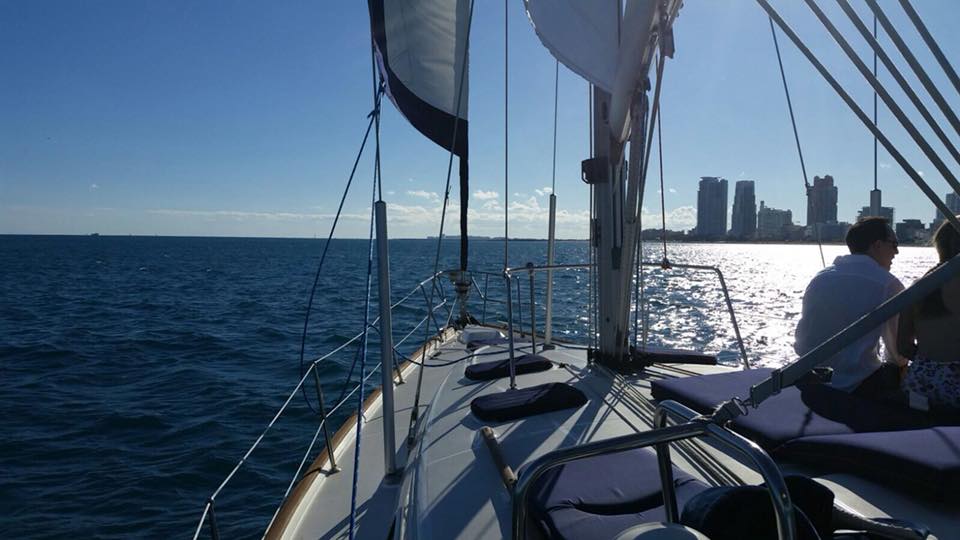
>>Also Read: Cruising Sailboats – Parts and Features
Hull Design
The hull of a good cruising sailboat should have relatively low freeboard (distance from the waterline to the upper edge of the deck) to minimize the impact of windage in extreme weather. It should also have a moderate beam, a bit of forefoot beneath the waterline, and a full keel or a moderately proportioned fin keel to help with heaving. The cockpit should be large enough to be comfortable in normal conditions but not overly large. If you’re ever pooped, a too-large cockpit will hold that much more water, the weight of which can depress your stern and make you vulnerable to being pooped again.
All deepwater boats should have a bridgedeck “step” of sorts between the front of the cockpit and the companionway leading below, so water from a flooded cockpit won’t slop into the cabin. The cockpit should also be equipped with large drains to allow water that comes aboard to leave as quickly as possible.
Finally, a blue water cruiser must have a safe limit of positive stability (LPS)—at least 120 degrees, although higher is better—to prevent it from capsizing in heavy seas. LPS is the heel angle at which the hull and keel stop resisting the capsizing forces of the wind and waves and actually abet them until the boat is completely inverted. In addition, the LPS dictates how stable a boat will be when it’s upside down—in other words, how easily the boat will re-right itself. As Calder explains, a sailboat with an LPS of 100 degrees will, in theory, remain inverted for about 5 minutes before it’s righted again by wave action.
A sailboat with an LPS of 120, on the other hand, should right itself in about 2 minutes. A sailboat with an LPS of 140 will theoretically pop right back up almost as soon as it goes over. Think about how long you can hold your breath—and about how long your hatches, hatchboards, vents, and portlights will hold when the boat is upside down in surging conditions. A couple of minutes could make all the difference in the world. For the record, many sailors believe that an LPS of 115 degrees is acceptable on an offshore boat.
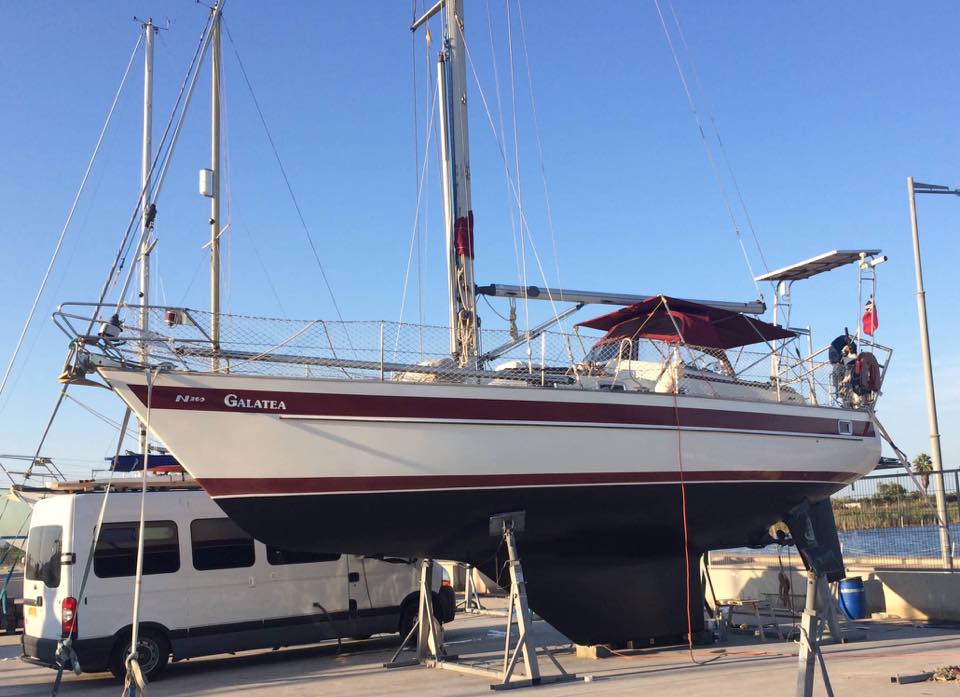
>>Also Read: Full Vs Fin Keel On Sailboats
Comfort and Ease of Sailing
Many of the features that make for a seaworthy boat also make for a seakindly one. A sailboat with a moderate length-to-beam ratio, a bit of forefoot, and a full keel or moderately proportioned fi n, for example, not only heaves-to well but also tends to track better. Granted, the boat might not be the fastest thing on the water, but what cruising sailor wants to continually tweak and trim to eke out that last fraction of a knot of boat speed anyway? Likewise, a solid masthead rig with a moderate sail area will get you where you want to go without springing any nasty little surprises.
In Nigel Calder’s (sailing writer) words, “On a cruising boat, it is a fundamental mistake to gear the concept of fast passage making to maximizing the absolute speed potential of a boat at the expense of ease of handling, comfortable motion, stability, security, and other highly desirable attributes. Exhilarating performance can be fun in the short term but extremely fatiguing in the long term. Instead, the goal should be to achieve good sustained performance in all kinds of conditions in an environment that is as relaxing and as much fun as it can be.”
A deepwater boat should have V-shaped sections in the bow that will allow the hull to slice through the waves on a beat or close reach, instead of slapping and pounding. It should also be stiff enough to carry sail, but not so stiff that it has a “snappy” motion when coming off a swell—which calls for a moderate L/B to ensure adequate but not too much form stability. In this same vein, a boat with a moderate to heavy displacement-to-length ratio—unlike a featherweight speedster—tends to pass smoothly through the waves instead of bouncing over them or simply bobbing on top of them like an oversized cork.

>>Also Read: Must-Have Boat Safety Equipment For Sailing
Accommodations
The list in this category is pretty exhaustive. An ocean is a big place, but for the crew of a sailboat on passage, it’s essentially no bigger than the boat’s LOA (Length Overall). Nonetheless, the shortlist includes adequate sea berths, a galley that can be safely used in a seaway, plenty of storage, and a cockpit that’s comfortable and safe for watchkeeping.
When it comes to sea berths, simpler is better. Each berth needs to be a little more than 6 feet long and located no farther forward than around amidships. The motion in a forepeak berth in any kind of seaway will make sleeping impossible. Berths should also be parallel with the boat’s centerline, not angled dramatically inward. Otherwise, either your head or feet will be higher whenever the boat heels while you’re trying to sleep. Finally, sea berths should be straight to avoid cramped shoulders or feet. This consideration may seem obvious, but many modern cruising boats are equipped with curved or angled settees—those seats in the saloon that double as sea berths underway— which look great at boat shows but can be absolutely miserable for sleeping.
In the galley, you need a cooking area that not only includes the necessary equipment for preparing meals—stove, microwave, oven, cutting board, and the like—but a layout that will make cooking safe and as easy as possible when the boat is sailing on its ear. The key is a wraparound layout, in which the counters form a U or G shape, so you can brace yourself against an opposing counter or in a corner and free your hands for cooking.
Sinks should be deep and as close to the centerline as possible, where the motion is less severe. Fiddles—the little walls or barriers surrounding the countertops to stop things from sliding off —need to be tall and perpendicular, not low and artistically rounded. The galley should be located as close to the companionway as possible for ventilation and ease of passing snacks or coffee to crewmembers on deck. A location near the companionway also puts the galley well aft, where hull motion is easier.
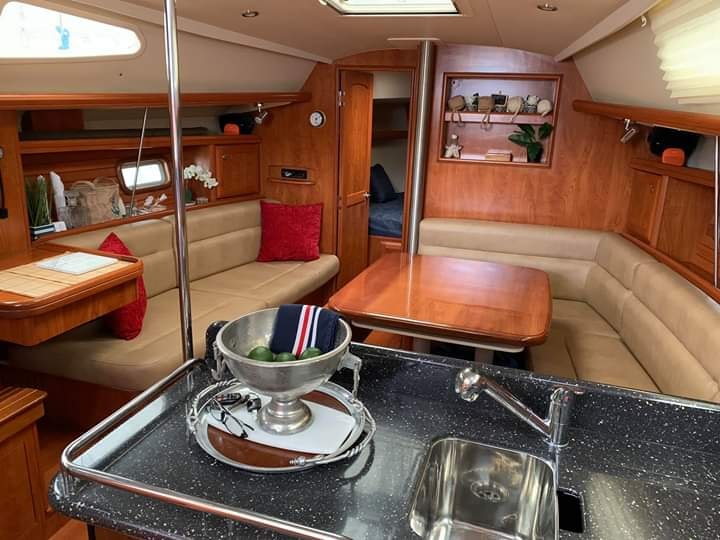
>>Also Read: What To Wear When Sailing
Storage
You can never have too much storage. Extended cruising requires a tremendous amount of storage space—for everything from charts to food to spare engine parts and toothpaste—and unless your boat is 50 feet or longer, there’s barely enough room for everything. Not only that, storage space can be surprisingly scarce even in larger cruisers, as designers struggle to shoehorn in more and more accommodations per foot of LOA. The double-size quarter berths tucked under the cockpits of many newer boats may look great. Still, the only way to fit them in is to eliminate a voluminous amount of storage that is otherwise available under the cockpit seats.
Large staterooms in the bow take away hull volume that could otherwise house wet lockers for storing damp foul-weather gear, and “sugar scoop” transoms with those oh-so-convenient swim steps leave no room for lazarettes—those wonderfully spacious lockers located aft of the cockpit. Next time you’re at a boat show, do a quick inventory of that 45-foot beauty with the multiple heads and staterooms. See what’s behind some of those lovely cherry-finished doors, and tally up the total storage area—including those “cabinets” that are so tiny they’re essentially useless. You may be surprised that a “big” boat can actually have remarkably little room for putting things away.
Cockpit
The cockpit should be the right size to “enclose” the on-watch crew—usually one person unless the boat and crew are very large—so they don’t have to worry about being washed around in heavy weather conditions. A cockpit’s width and length are key; there are few things in this life more reassuring than tucking yourself in where the cockpit seat meets the cabin trunk and having your feet braced against the cockpit seat or seat back to leeward— an unrealized comfort if the cockpit is too wide. In addition, all the necessary control lines should be close at hand. The helmsman shouldn’t have to let go of the wheel or tiller when trimming either the main or the jib sheets. The cockpit should also have several strong points where you can secure a safety harness and easy access to jacklines without having to expose yourself to the waves.
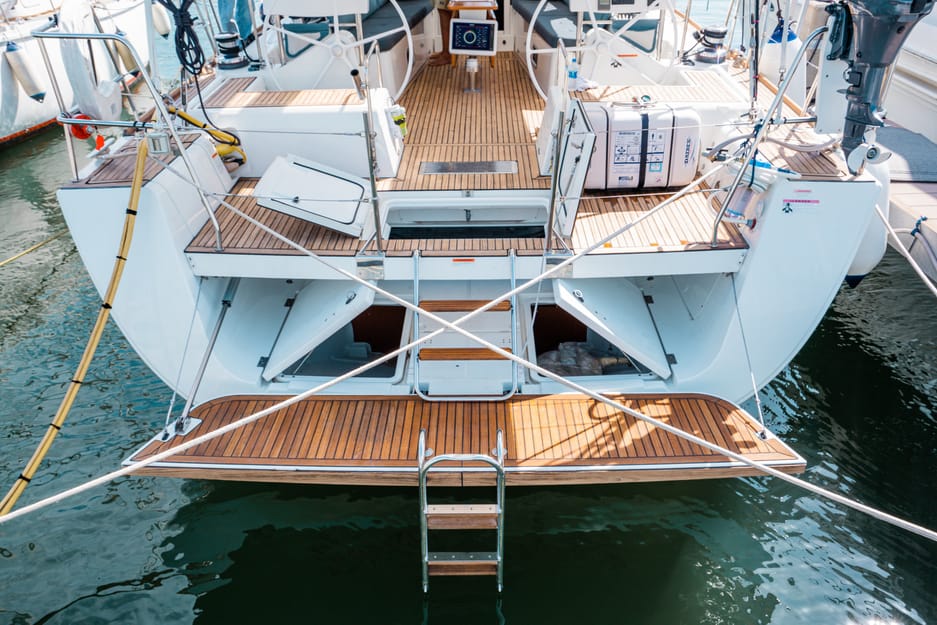
What Makes a Good Offshore Blue Water Sailboat? – Summary
To reiterate, these are just a few features of a good cruising sailboat—albeit critical ones. The real key that makes a good offshore sailboat is to find one that’s functional and moderate in the areas of sailing and accommodations; fast but not too fast; roomy but not too roomy; and in which everything has a purpose. After all, crossing an ocean in a tiny sailboat is serious business—tremendously satisfying, but serious nonetheless.
